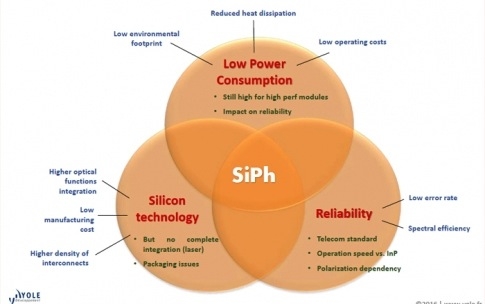Silicon Photonics - from promise to reality in datacentres

![]()
Figure 1. Key advantages for silicon photonics for datacentres, from 'New Technologies & Architectures for Efficient Data Centers', by Yole Développement. Courtesy of Yole Développement. More information on www.i-micronews.com.
In 2015, the power needs of datacentres represented 1.62 percent of worldwide energy production. That number will continue to grow, reaching a value of 1.9 percent by 2020 according to the recent market report "New Technologies & Architectures for Efficient Data Centers', by Yole Développement (July 2015 edition). The main contributors to that rise will be the ever increasing demands of cloud storage capacity and data flow speed.
Networking equipment consumes about 50 percent of a typical datacentre's energy. Air movement and cooling equipment consume about 37 percent, transformers and uninterruptible power supplies account for 10 percent and lighting and other items take another 3 percent. The easiest solution is to focus on innovative technologies that can enable more efficient networking equipment with less loss sources, and hence, fewer cooling requirements.
The large internet companies (e.g. Apple, Amazon, Google, Microsoft,"¦) see this as a challenge, shown by the fact that a third of their global investment goes on maintenance of existing datacentres and the creation of new ones. However, this has been seen by many as the long awaited window of opportunity for the silicon photonics technology. Silicon photonics is, in a sense, the natural evolution of electronic integrated circuits, "enabling high level of integration, improved interconnect density and longer distance links", (to quote Bert Jan Offrein, manager of photonics at IBM Research Zurich), while making use, to a large extent, of mature CMOS production processes.
It is safely estimated that replacing DDR3 motherboards with silicon photonics technology for chip-to-chip communication in networking equipment can significantly lower the power budget for 1TBps transmission from 240W to 8W.
But silicon photonics is not a new technology. During the1980s and '90s work by Richard Soref (at the US Rome Air Development Center) and Graham Reed (then at the University of Surrey, now at the University of Southampton), already showed low loss propagation of optical signals was possible using CMOS compatible silicon photonics technology. And in 2006, a Variable Optical Attenuator (VOA) developed by the company Kotura was the first silicon photonics product on the market. As of today, only a very limited silicon photonic based product range is commercially available, and those products consist mainly on VOAs, Active Optical Cables (AOCs) and transceivers by Luxtera, Kotura/Mellanox and Cisco/Lightwire.
So why is there such a slow take-up of a technology which has apparently reached the maturity needed for industrial deployment and which seems like a perfect match for datacentres?
One possible answer to that is that until now the main challenge has been the high volume manufacturing for the assembly and integration of the electronics and silicon photonics. Until now, the silicon photonic based products are preassembled, before their integration into the electronic system.
But things may change very rapidly. Last year, Offrein"˜s group at IBM proposed an integration scheme in which the silicon photonic chips were directly attached to the processors without pre-assembling them into standard transceiver housings. This is a major breakthrough, that should end up with silicon photonics replacing all copper cabling at datacentres enabling faster data transmission moving from 40Gb/s to 100Gb/s, without distance limitation.
Learn more at PIC International 2016
Creating and strengthening links between chipmakers and network builders
1st-2nd March, 2016, Sheraton Brussels Airport Hotel, Belgium
www.picinternational.net
Attendees at the Photonic Integrated Circuit International conference will hear leading industry- insiders delivering 34 presentations spanning six key themes and in addition will have a unique opportunity to meet other key experts within this community.
Visit:
Conference web site: www.picinternational.net
Conference agenda: www.picinternational.net/agenda
Conference Register: www.picinternational.net/register
EPIC: www.epic-assoc.com


































